How AI Adjusts Pest Control in Real Time
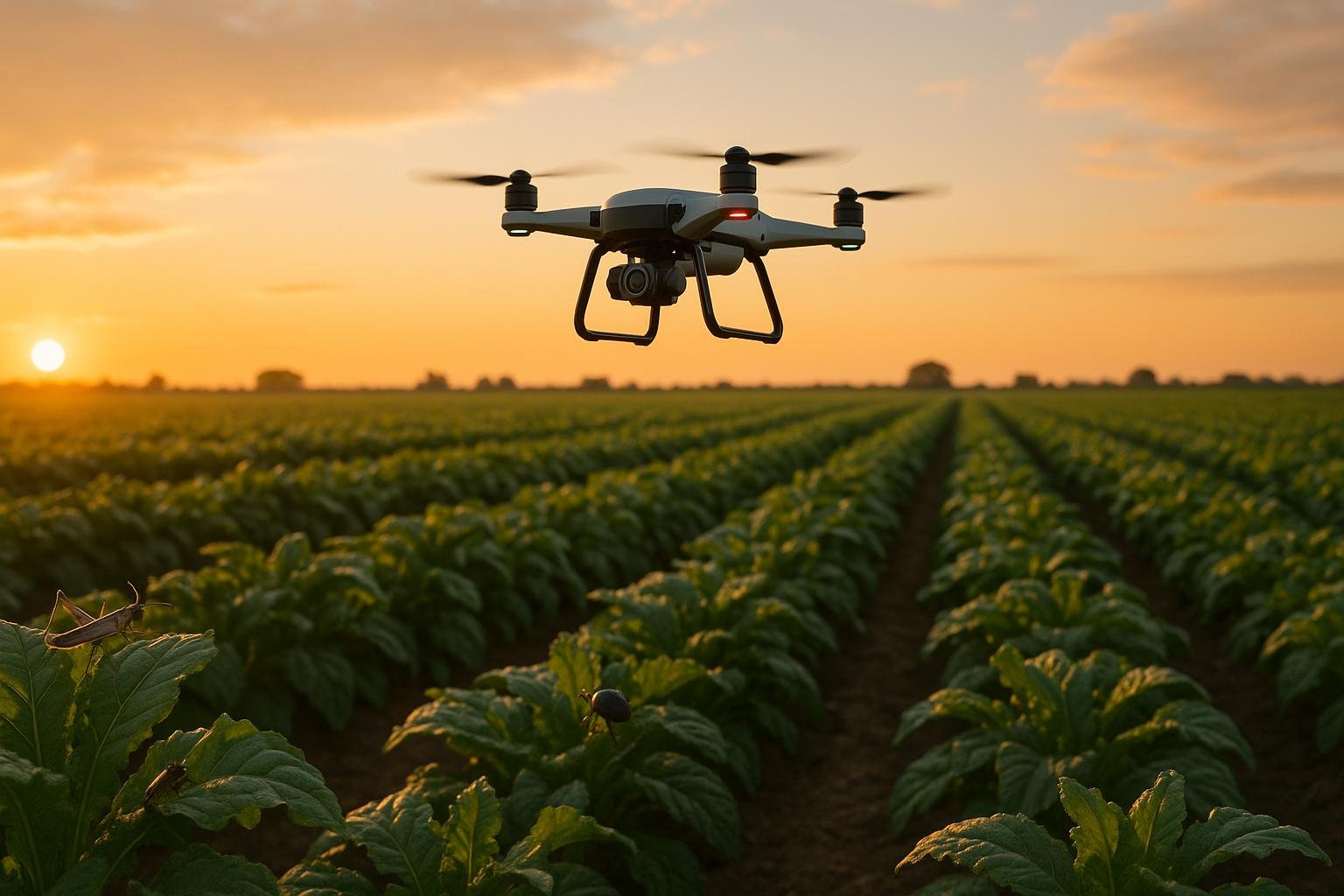
Artificial Intelligence (AI) is transforming pest control by using real-time data to detect, monitor, and manage pests more effectively. Unlike older methods that rely on scheduled treatments and manual inspections, AI systems analyze live data from sensors, cameras, and weather patterns to make instant decisions. This approach reduces chemical usage, improves crop yields, and saves time.
Key takeaways:
- AI accuracy: Over 95% in detecting pests, even in poor conditions like rain or low light.
- Efficiency: Cuts scouting time by up to 60% and pesticide use by up to 30%.
- Economic impact: Pests destroy 20–40% of crops annually, costing $290 billion globally. AI helps minimize these losses.
- Advanced tools: Systems like Blue River’s "See & Spray" and Semios’ predictive models improve pest control precision.
AI-powered pest control provides faster, data-driven solutions to reduce crop damage and lower costs, ensuring better outcomes for agriculture.
AI counts flea beetles in real-time

Core Technologies for Real-Time Adjustments
AI-driven pest control hinges on technologies that allow for immediate pest monitoring and response. These advancements transform pest management into a precise and timely decision-making process.
Sensor Networks and Smart Traps
At the heart of modern pest control are intelligent sensor networks. These systems use a mix of sensors - tracking movement, heat, humidity, temperature, and even gases - to monitor pest activity and environmental conditions in real time.
Take Anticimex's SMART Digital Rodent Control System, for example. It uses GSM data trends to predict rodent infestations, offering a proactive approach to pest control [6].
Smart traps have also come a long way. The Spensa Z-Trap, for instance, combines pheromone lures with electrified rods to eliminate insects. It uses bioimpedance sensors to rapidly classify species, sending the data to a cloud server for easy access via web applications [6]. Similarly, Trapview incorporates cameras inside pheromone traps, uploading images through SIM cards to cloud servers where algorithms classify pests using GPS data [6].
The impact? These tools significantly cut response times. Precision Pest Control reported a 40% reduction in response times, while Insectek Pest observed a 35% improvement in detection accuracy thanks to continuous monitoring [6]. Environmental sensors further enhance these systems by tracking factors like temperature, humidity, and soil moisture, helping AI identify conditions that encourage pest growth.
AI Models for Pest Identification
Artificial intelligence plays a key role in identifying pests with speed and accuracy. Convolutional Neural Networks (CNNs) and models like YOLO have proven to be highly effective, achieving accuracies above 92% and even reaching 100% for specific species. For instance, researchers at Jilin Agricultural University in China developed a model that classified insects by age across 23 developmental stages for four pests. Their approach, combining deep learning with data optimization, achieved an impressive 96.65% accuracy [3].
YOLO models are particularly strong in real-time pest detection. In one study using camera trap images, YOLO achieved an average precision of 92.7% and a recall rate of 93.8% across nine insect species [4]. Some specialized systems, like an SVM model, have even hit 100% accuracy in identifying five fly species [5]. These AI tools can process thousands of images daily, allowing pest problems to be identified and addressed within hours instead of days.
Integration with User Devices
The power of AI-driven pest control is amplified through integration with smartphones, tablets, and other devices. These integrations simplify complex data into actionable insights, making it easier for users to respond effectively. For instance, AI-powered customer support systems streamline call triage, route urgent cases quickly, and even automate appointment scheduling [6].
One residential pest control provider saw hold times drop from five minutes to under a minute after implementing an AI phone platform, boosting customer satisfaction by 20% [6]. In commercial settings, AI systems have proven equally effective. A pest control firm working with local restaurants used AI to handle after-hours emergencies, triage calls, and book appointments for non-urgent issues. This approach not only improved efficiency but also helped the company secure long-term contracts [6].
Mobile apps further enhance pest control by delivering real-time alerts, treatment recommendations, and progress tracking. These systems continuously analyze call patterns and recurring issues, offering valuable insights for improving service. Features like follow-up reminders and feedback requests create a proactive cycle of monitoring, treatment, and adjustment, shifting pest control from a reactive process to a forward-thinking management system.
Together, these technologies pave the way for more advanced data collection and analysis, setting a new standard in pest management.
Data Collection and Analysis Methods
AI-driven pest control systems rely on gathering and analyzing data from various sources to predict and tackle pest issues quickly. By processing this information in real time, these systems can identify potential threats before they escalate into significant problems.
Weather and Historical Data
Weather patterns and historical records are essential to AI pest prediction models. Factors like temperature, humidity, rainfall, and seasonal changes are closely linked to pest behavior, reproduction cycles, and migration patterns. AI algorithms analyze these environmental variables alongside past outbreak data to predict when and where pests are likely to emerge.
Take the "Pest Forecast" platform developed by the Commonwealth Scientific and Industrial Research Organisation (CSIRO) in Australia as an example. This system combines weather forecasts with historical records, using machine learning to predict pest activity. By providing early warnings, it helps farmers act before infestations occur [1].
Historical records play a crucial role in training AI models to detect patterns in pest outbreaks, crop types, and weather trends. This enables predictions of pest populations weeks, months, or even years in advance [1]. Weather stations also continuously collect climate data, which AI systems integrate with agricultural and pest life cycle information to create highly accurate prediction models. For instance, AI can identify specific temperature and humidity conditions that promote pest breeding, triggering preventive measures before a problem arises.
These weather-based predictions are not just theoretical - they help reduce economic losses by enabling farmers to prepare for and mitigate risks. When combined with real-time data processing, they provide a powerful tool for immediate and effective intervention.
Real-Time Data Processing
While historical data helps set the foundation, real-time data processing is what drives quick responses to new pest threats. AI systems analyze incoming information from sensors, environmental readings, and traps to detect pest activity as it happens.
One example is EFOS Ltd.'s Trapview system, which uses IoT-enabled insect traps equipped with cameras and sensors. These traps collect data on pest populations in orchards and vineyards, and AI algorithms analyze the information. When pest levels reach concerning thresholds, the system alerts farmers, enabling timely action [7].
Real-time processing integrates multiple data streams. Soil health sensors monitor moisture and nutrient levels, while environmental sensors track temperature and humidity throughout the day. High-resolution imaging, such as hyperspectral and multispectral imaging, detects crop stress caused by pests before any visible signs appear [7]. This early detection allows farmers to intervene before infestations spread.
For example, in cotton farms, AI-powered cameras and microphone sensors, combined with advanced deep learning algorithms, can detect insects with an accuracy of 70% to 98% [7]. This high level of precision minimizes false alarms, ensuring farmers only act when necessary.
By filtering thousands of data points every hour, real-time systems identify pest-specific patterns. AI then determines the species involved and predicts the likelihood of infestations, delivering actionable insights within minutes.
When real-time data is combined with historical records, it creates a complete view of pest activity. Comparing current conditions with past trends allows AI to spot unusual patterns that may signal new threats. This dual approach enables both immediate responses to active infestations and proactive measures based on predictive analytics, giving farmers the tools they need to stay ahead of potential problems.
sbb-itb-4d6a8dd
🚀 Ready to Reinvent Your Garden?
Join thousands of homeowners who have transformed their gardens using our AI design tool. Upload one photo to explore endless possibilities.
Get your AI garden designs →Automated Recommendations and Protocol Adjustments
AI systems take data from sensors, weather stations, and monitoring devices and transform it into actionable pest control strategies. This process removes the guesswork, allowing farmers and pest control professionals to act with precise timing and targeted methods. By combining real-time data with historical records, AI refines pest control protocols to fit specific scenarios. Let’s break down how this technology tailors interventions.
Custom Pest Management Plans
AI uses sensor data to create pest management strategies that are customized for specific locations. These strategies account for factors like crop type, local climate, soil conditions, and past pest activity. The result? Management plans that adapt as conditions change.
For instance, FarmSense employs a pest-monitoring platform that gathers data on insects and environmental conditions directly from the field. This data is processed in the cloud, enabling the AI to understand each grower’s unique situation. The system then suggests targeted strategies, such as the best times to spray for navel orangeworms in nut orchards [1]. This approach ensures interventions are tailored to local needs.
AI also adjusts for economic thresholds. Detection sensitivity can vary depending on factors like economic impact, health and safety standards, legal requirements, and tolerance for aesthetic damage [8]. For high-value crops, the system might recommend quick action at lower pest levels. On the other hand, in less critical areas, it might delay intervention until pests reach a higher threshold.
A notable example comes from Tamil Nadu Agricultural University, which developed a mobile app using Deep Convolutional Neural Networks to detect fall armyworm infestations in maize. The app achieved a 93.47% validation accuracy and 98.47% training accuracy, providing farmers with pest-specific treatment recommendations based on infestation severity.
Examples of Precision Protocols
AI-driven precision protocols are transforming pest control, significantly cutting chemical use while maintaining or improving outcomes. These systems enable highly targeted treatments.
One example is weather-optimized protocols. AI systems analyze factors like temperature, wind speed, humidity, and precipitation to determine the best times for pesticide application. This optimization can cut pesticide waste by up to 30% and boost crop yields by 15–20% compared to poorly timed applications [9].
Semios, in partnership with Google, offers another powerful example. They used AI to reduce a moth population by 1.5 billion insects while simultaneously increasing almond production [1]. This large-scale effort demonstrates how AI can coordinate pest control across vast areas, achieving maximum effectiveness with minimal environmental impact.
Real-Time Alerts and Notifications
AI systems take pest control a step further by providing instant alerts when pest activity crosses critical thresholds. These notifications allow for immediate intervention, preventing minor issues from escalating into major infestations [10].
"AI detection systems automate pest identification and monitoring using cameras and sensors that collect data such as heat, movement, and sound."
- FieldRoutes [8]
Rentokil Pest Control’s Remote SMART™ Monitoring system, equipped with PestConnect Optix, operates continuously in high-risk areas. It uses imaging devices to detect movement and capture images within 0.5 seconds. AI then identifies the pest type, enabling technicians to respond quickly [10].
In February 2025, BrightAI partnered with Pelsis Group to launch an AI-powered pest monitoring system integrated into Pelsis' Halo and Flytrap products. These systems provide around-the-clock surveillance, sending alerts when pests are detected. AI models analyze images to identify species and track infestation trends, offering actionable insights. Technicians receive notifications via a mobile app, directing them to problem areas for swift intervention. This approach reduces pesticide use while preventing outbreaks [11].
"Pest control in food and pharma is about more than managing nuisances - it's about safeguarding supply chains and protecting public health."
- Alex Hawkinson, Founder and CEO of BrightAI [11]
The speed and accuracy of these systems are game-changers. AI pest control systems can identify pests with over 96% accuracy and process data at speeds of 16–29 frames per second [8]. Alerts are sent within minutes of detection, ensuring timely responses.
"Customers are seeing the immediate value in reducing operational risks and preventing costly downtime. This technology doesn't just solve problems - it stops them before they start, and we're eager to see how it continues to elevate safety and efficiency in these critical industries."
- Claire Larcombe, Global Portfolio Director at Pelsis [11]
In sensitive environments like food storage facilities, where pests can lead to costly shutdowns and regulatory issues, real-time monitoring builds confidence. Continuous surveillance ensures that pest activity is detected and addressed immediately, rather than relying on periodic inspections that might miss critical windows for action.
Benefits and Challenges of AI-Driven Pest Control
AI-driven pest control offers a modern twist on traditional methods, bringing clear improvements while presenting some unique hurdles. By understanding both the advantages and challenges, gardeners and professionals can make better choices about adopting these technologies.
Advantages Over Standard Methods
AI-powered pest control isn’t just about automation - it’s about doing things smarter. These systems bring noticeable improvements in accuracy, efficiency, and reduced environmental impact.
For instance, advanced AI tools can track pests with impressive precision, boasting detection rates of over 90.18% for pests and 90.4% for diseases like apple black rot [12]. This level of accuracy is particularly useful for catching problems early, something that manual inspections often miss.
Another big win? Less reliance on chemicals. AI systems apply treatments more precisely, reducing overuse. Plus, they save time and labor. Compared to manual methods, AI-powered solutions can slash data collection and analysis time by up to 90% [15]. This frees up professionals to focus on strategic decisions and targeted actions.
The benefits don’t stop there. AI’s ability to detect pests early, apply chemicals more selectively, and speed up response times makes it a game-changer. This is crucial, especially when you consider that 64% of global agricultural land faces risks from pesticide pollution [16]. On top of that, 72% of farmers using AI pest management report less environmental damage and better resource efficiency [12]. These combined advantages lead to significant gains in efficiency, as outlined below.
Efficiency Improvements
AI changes pest control from a reactive process to a proactive one, making operations much more efficient.
With continuous monitoring, AI reduces the need for frequent field visits and manual inspections. Traditional methods often miss early warning signs, but AI’s constant vigilance ensures quicker detection and intervention. And with plant diseases costing the global economy over $220 billion annually and pest-related losses adding another $70 billion [16], early action is critical. Companies like Farmsense plan to charge customers around $300 per season for AI-powered services, while GoMicro is gearing up to offer $1 smartphone-compatible microscope accessories for pest analysis [16].
AI also boosts technician productivity. Automated monitoring allows technicians to focus on problem areas flagged by data alerts, enabling them to cover more ground and resolve issues faster.
The rapid growth of AI in agriculture - from $1.7 billion in 2023 to an estimated $4.7 billion by 2028 - shows just how valuable these efficiency improvements are [17]. By providing consistent, data-driven insights, AI reduces guesswork and improves decision-making, leading to better outcomes overall.
Challenges to Address
Despite its many strengths, AI-driven pest control isn’t without its challenges. Several technical and environmental issues still need to be ironed out.
Technical Reliability is a common concern. Remote devices can face problems like high power consumption, unstable networks, hardware defects, software glitches, and exposure to harsh environmental conditions [13]. Any of these could disrupt vital monitoring operations.
Environmental Factors also play a role. Wind, shifting light conditions, and limited visibility as plants grow can affect sensor accuracy and limit their ability to provide a full picture [13].
Data Quality and Coverage is another issue. Uneven pest distribution can result in gaps in sensor coverage, potentially leading to missed infestations [13].
AI System Limitations are worth noting, too. Some systems struggle to differentiate between pest species, developmental stages, or even beneficial insects [13].
Implementation Barriers also slow adoption. High upfront costs, along with concerns about data privacy and security, can be daunting - especially for smaller operations that may lack technical expertise [17].
There’s also the risk of System Exploitation and Safety Concerns. AI systems can sometimes find unintended loopholes in their programming, a phenomenon known as specification gaming or reward hacking [14]. Additionally, some companies may rush to deploy systems without fully addressing safety measures, leading to unintended behaviors. As AI pioneer Norbert Wiener warned:
"If we use, to achieve our purposes, a mechanical agency with whose operation we cannot interfere effectively ... we had better be quite sure that the purpose put into the machine is the purpose which we really desire." [14]
Ensuring accessibility for smaller farmers is crucial [2]. At the same time, Regulatory and Compliance Issues - from data privacy to meeting regulatory standards - pose ongoing challenges [2].
Overcoming these obstacles will require continuous research, better training programs, and policies that make AI-driven pest control more effective and accessible for everyone.
Conclusion
AI has brought a game-changing approach to pest control, shifting from traditional reactive methods to proactive, data-driven solutions. By enabling real-time monitoring and precise treatment protocols, AI offers more efficient and environmentally friendly pest management practices. With pests responsible for 20–40% of global crop losses and costing the global economy around $290 billion each year[18], the need for such advancements is clear.
Real-world examples highlight the impact of these technologies. For instance, industry case studies have shown that AI-powered systems can cut herbicide use by as much as 90% while significantly boosting crop yields through targeted interventions[1]. This not only reduces chemical dependency but also enhances agricultural productivity.
What sets AI apart is its ability to handle continuous monitoring and process real-time data - tasks that would be nearly impossible for human teams to manage 24/7. By integrating AI into pest control, the agricultural industry is better equipped to tackle one of its most persistent challenges.
FAQs
How does AI make pest detection more accurate and efficient than traditional methods?
AI is transforming pest detection by combining advanced algorithms, machine learning, and smart sensors to analyze data with impressive accuracy. This approach reduces the chance of errors when identifying pests and makes it easier to catch infestations early - something that can be tough to achieve with manual inspections.
With automated pest monitoring and real-time alerts, AI enables faster and more precise responses. This doesn’t just save time; it also cuts down on the need for broad pesticide application, promoting a more efficient and environmentally friendly approach to pest control.
What challenges do AI-powered pest control systems face, and how can they be overcome?
AI-powered pest control systems come with their own set of hurdles, such as data privacy concerns, regulatory hurdles, inconsistent data quality, high upfront costs, and technical integration difficulties. On top of that, accurately identifying and classifying pests (a process often complicated by taxonomic challenges) can sometimes limit how effective these systems are.
Addressing these issues requires a multi-faceted approach. Standardized data collection protocols can help tackle data inconsistency, while clear and well-defined regulatory guidelines can ease compliance worries. To make these systems more affordable, investing in scalable solutions is key. Additionally, offering better training for users and ensuring these tools integrate smoothly with existing systems can simplify adoption. With thoughtful planning and execution, AI-driven pest control has the potential to be both practical and effective, whether for small farms or large-scale operations.
How does AI use real-time and historical data to predict and manage pest outbreaks?
AI systems integrate real-time data - like weather conditions, pest activity, and other surrounding factors - with historical records, such as past infestation patterns and seasonal trends. With this combination, they analyze the information to predict pest outbreaks and recommend precise interventions.
Using advanced algorithms and predictive models, these systems deliver early warnings, allowing for smarter pest control strategies. This not only makes pest management more effective but also promotes environmentally friendly practices by cutting down on excessive pesticide use and reducing harm to the ecosystem.
🎨 Visualize Your Dream Garden Today!
Transform any outdoor space into a professional landscape design in minutes. Just upload a photo, choose your style, and let our AI do the rest.
Start your garden transformation now →Related posts
Related Articles
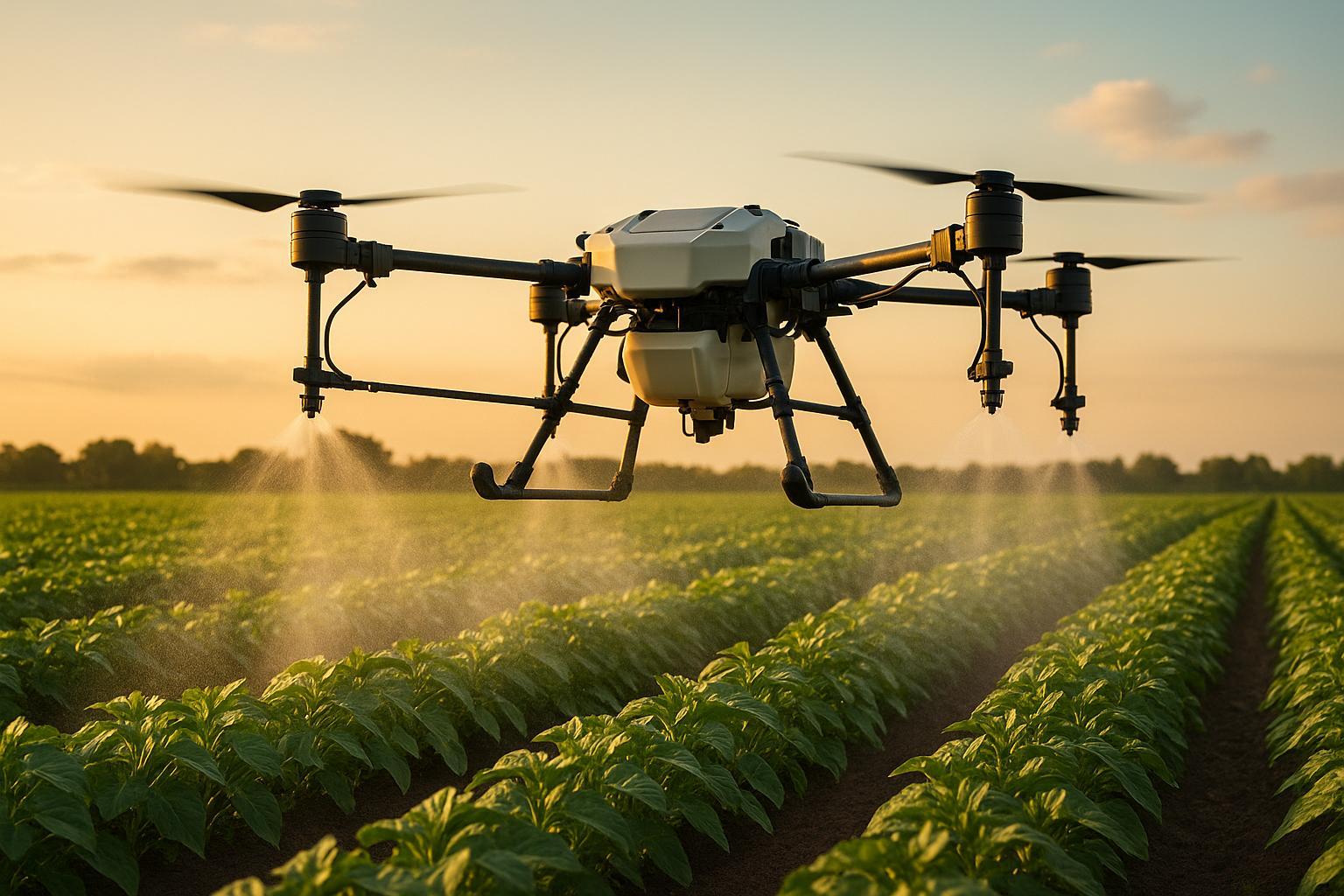
AI in Spray Coverage: How It Improves Accuracy
AI technology is revolutionizing agricultural spray coverage, enhancing precision while cutting costs and reducing environmental impact.
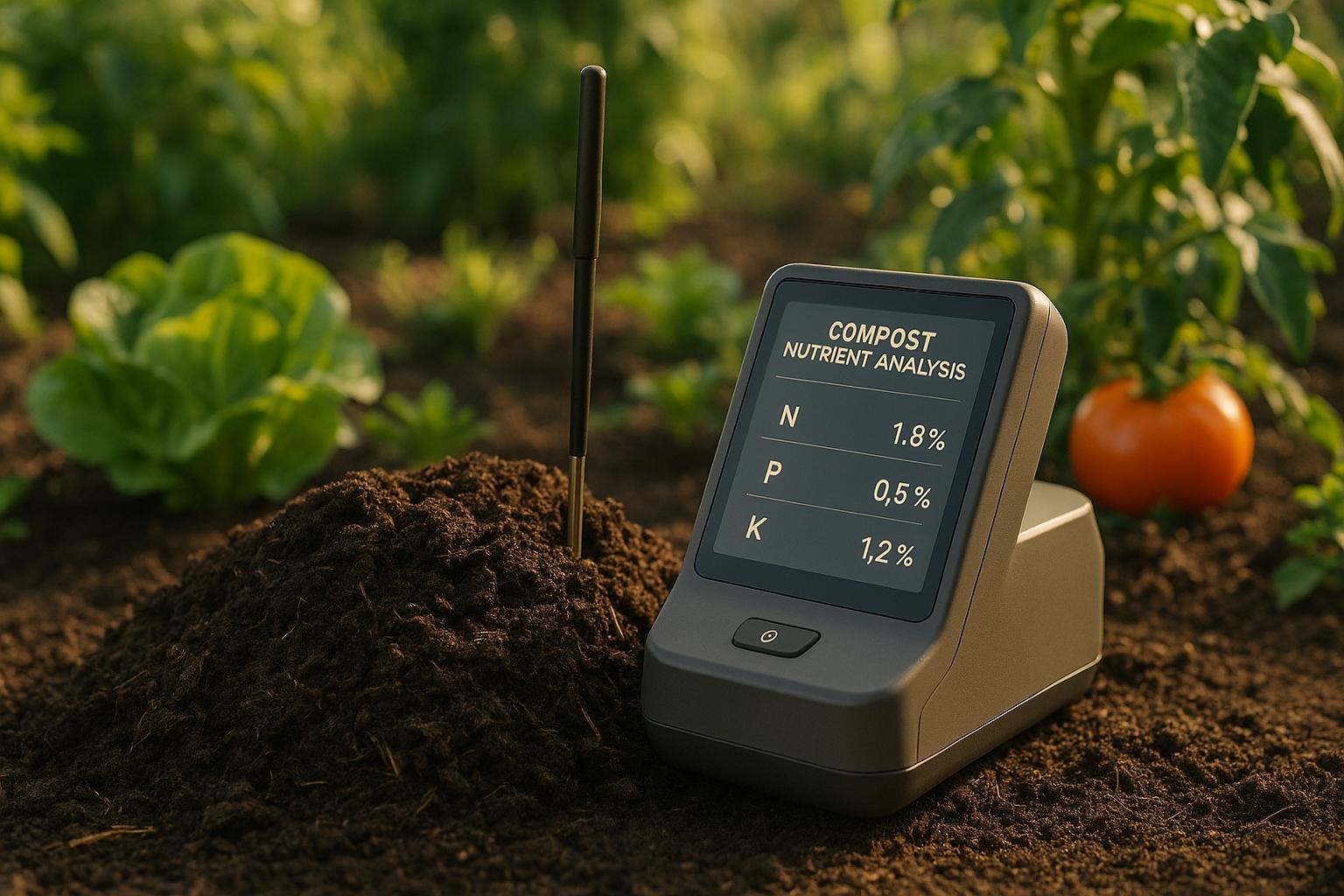
AI Tools for Compost Nutrient Analysis
Explore AI tools that enhance compost nutrient analysis, offering faster, accurate insights for gardeners and farmers at all levels.
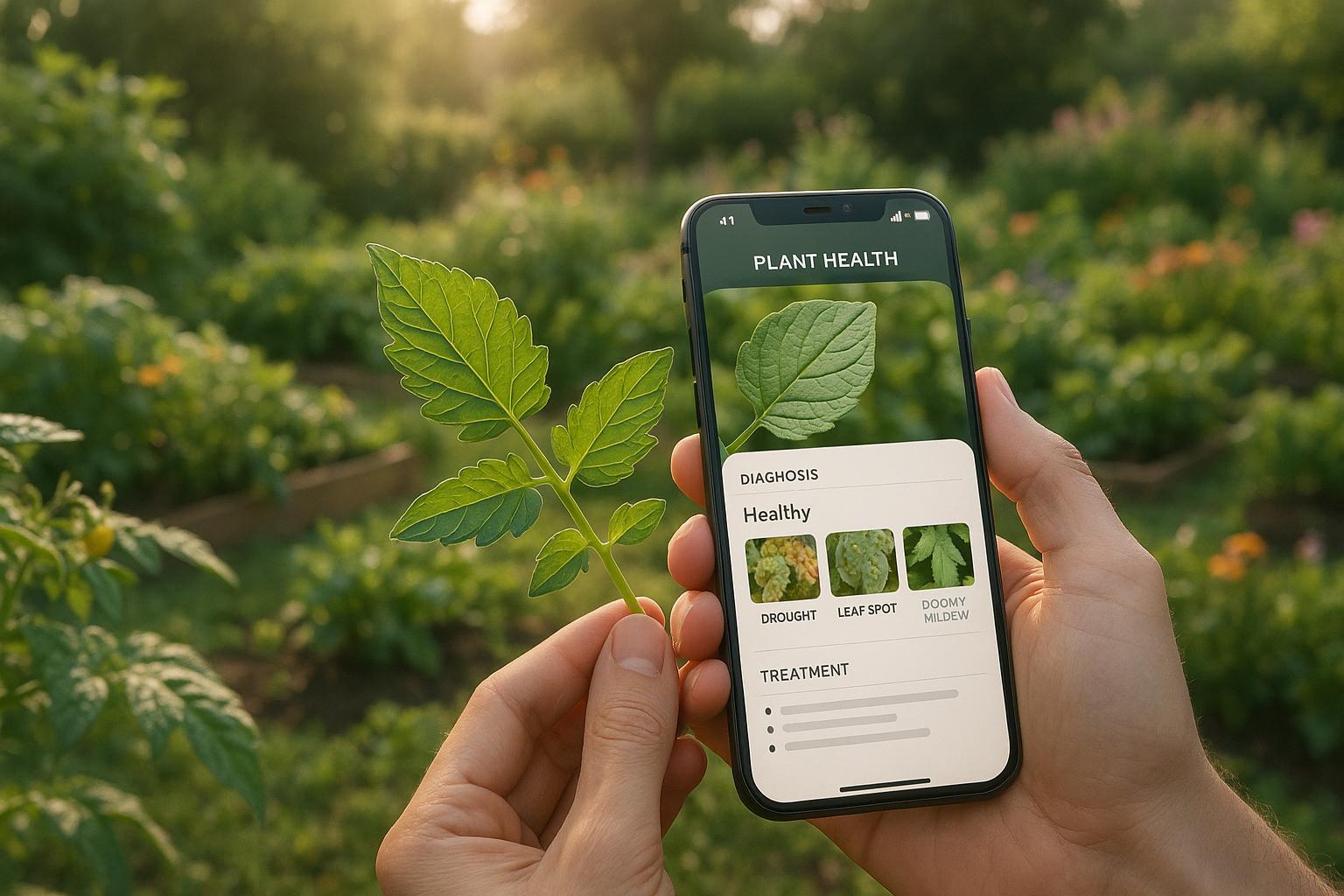
How AI Apps Predict Garden Diseases
AI gardening apps revolutionize plant care by enabling early disease detection, customized treatments, and proactive prevention strategies.

Top Plants for Carbon Sequestration
Explore how selecting the right plants for your garden can enhance carbon sequestration, support local ecosystems, and promote sustainability.
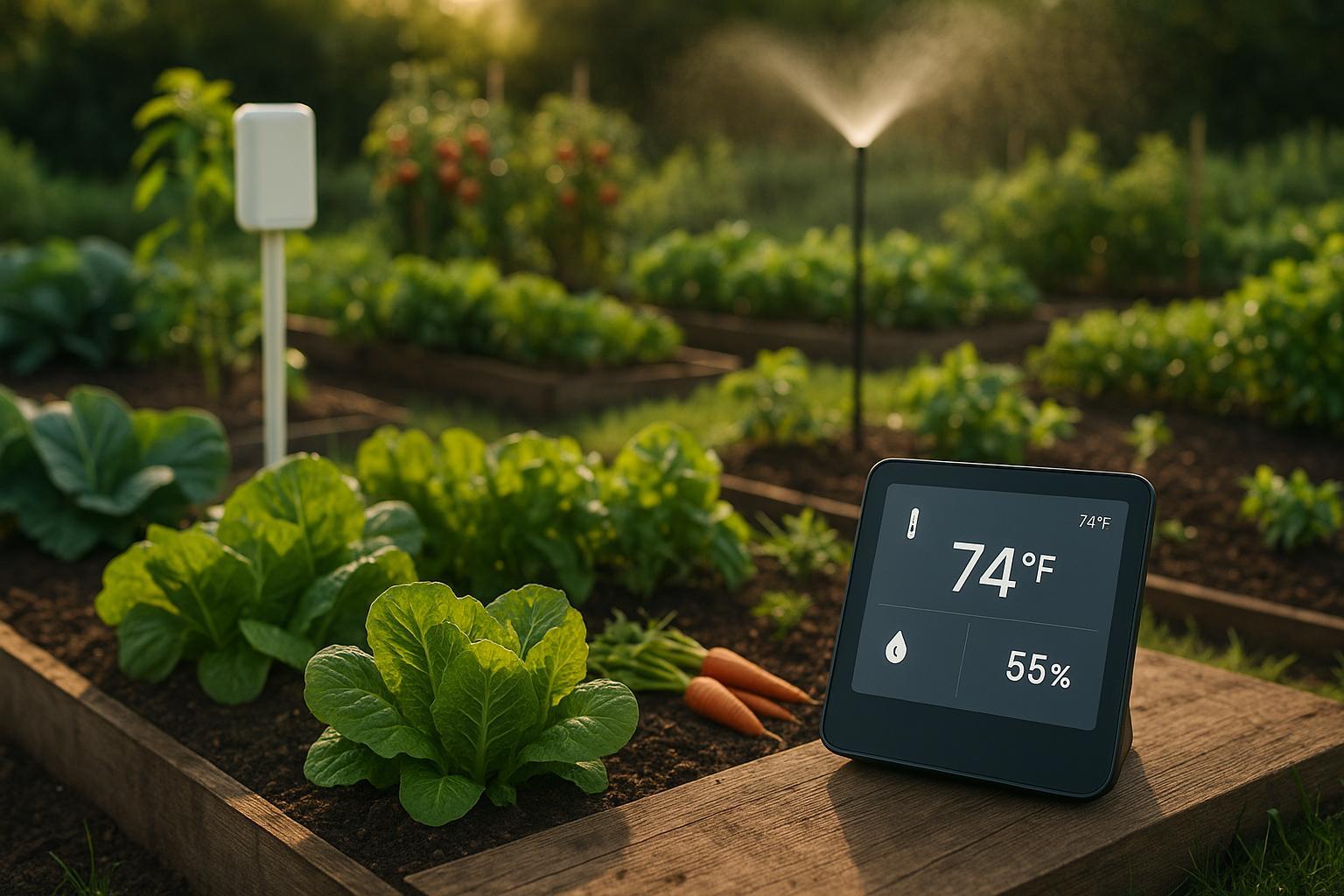
How Remote Climate Control Boosts Garden Productivity
Explore how remote climate control systems enhance garden productivity through automation, yielding higher returns and resource efficiency.
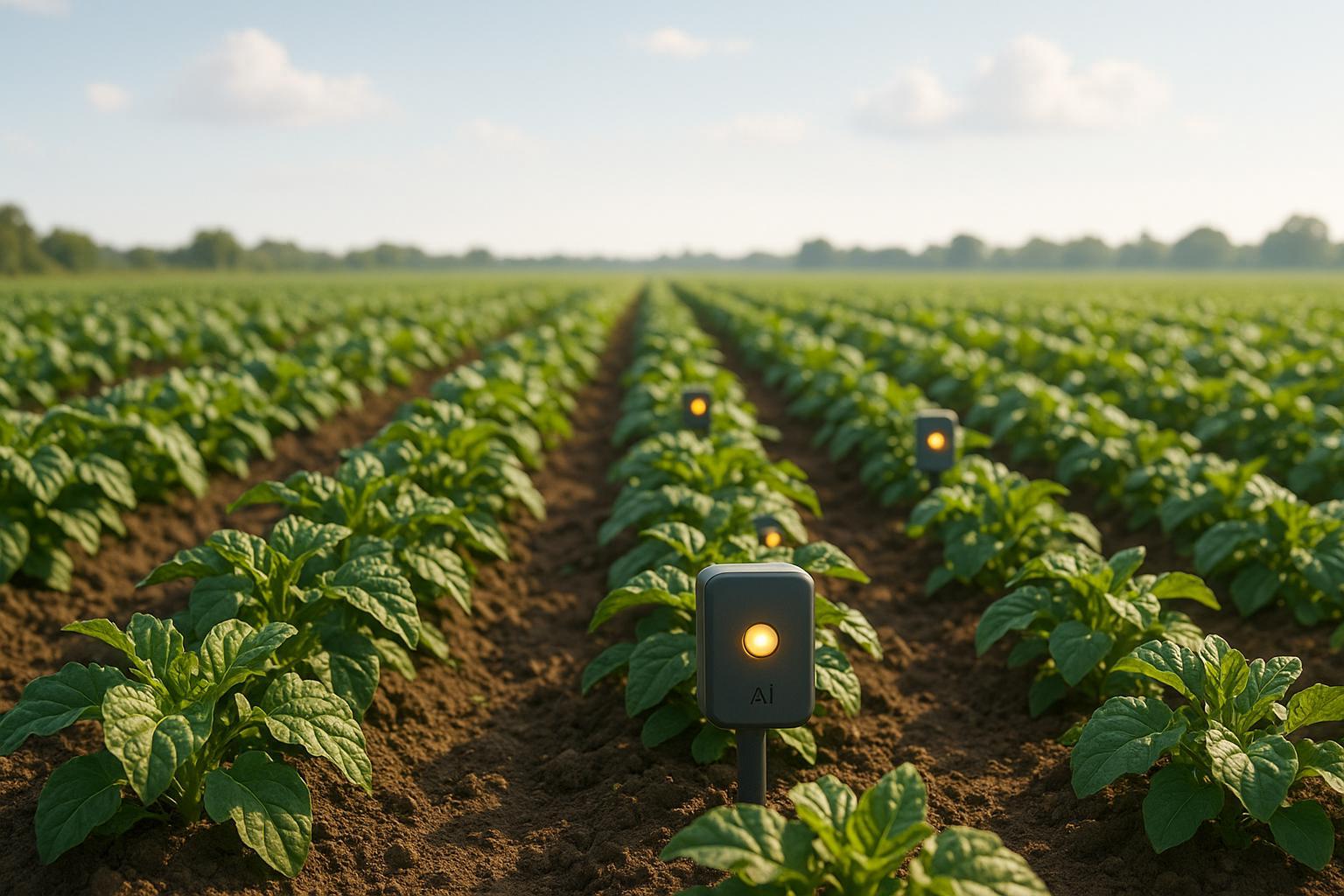
How AI Sensors Improve Seasonal Plant Monitoring
Explore how AI sensors revolutionize plant monitoring, enhancing resource efficiency, boosting yields, and enabling early disease detection.